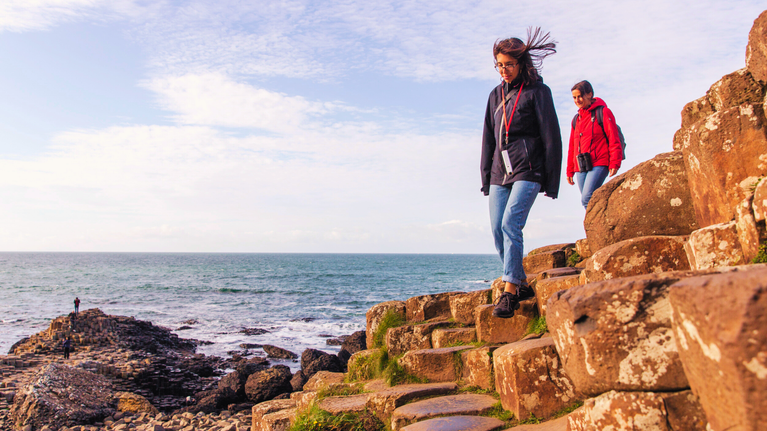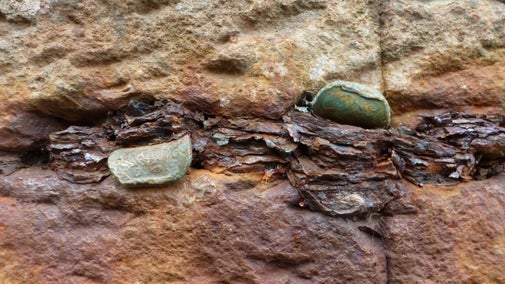
Book your visit
Please note: To avail of the best rates, it's strongly recommended that you pre-book your Giant's Causeway Visitor Experience tickets in advance of your visit.
Follow in the legendary footsteps of giants at Northern Ireland's iconic World Heritage Site.
44 Causeway Road, Bushmills, County Antrim, BT57 8SU
Book a visit
| Asset | Opening time |
|---|---|
| Coastline | Dawn - Dusk |
| Causeway Coast Way Car Park | 05:00 - 20:00 |
| Visitor Centre | 10:00 - 16:00 |
| Ticket type | With Gift Aid | Without Gift Aid |
|---|---|---|
| Adult (18+) | £14.00 | |
| Child (5-17) under 5s free | £7.00 | |
| Family (2 Adults and up to 3 children) | £35.00 | |
| 1 adult family | £21.00 |
Audio guide available in 11 languages as part of the Visitor Experience
Refreshments and snacks available within the Visitor Centre as part of the Visitor Experience.
Causeway Coast Way Car Park at Innisfree Farm, 60 Causeway Road is available for parking at £12 per vehicle for walkers to access the network of coastal paths. This is payable via the JustPark app, downloadable from Google Play and App Store. National Trust Members can park for free by entering their membership number. JustPark Location ID: 77819
Dogs on leads welcome in all areas of the Visitor Centre and across the World Heritage Site. Dogs on leads also welcome on guided tours.
Hourly guided tours available with our award-winning storytelling team as part of the Visitor Experience. Join the next guided tour from within the Visitor Centre.
Large shop, showcasing handmade craft and souvenirs, with over 80% made by local crafters, available to browse as part of the Visitor Experience.
Toilet facilities and Changing Places available within the Visitor Centre as part of the Visitor Experience. Exterior toilets available at the side of the Causeway Hotel for non-ticket holders.
Visitor Centre and Green Trail fully accessible. Changing places facility. Dog friendly inside and out. Wheelchairs and mobility scooters available for loan at no additional charge to members and Visitor Experience ticket holders.
Changing Places facility available for visitor's use during opening hours, please ask a member of the team for access.
Reserved on-site parking is included in your Visitor Experience ticket. Blue Badge parking is available on a first-come, first-served basis for Visitor Experience ticket holders and National Trust Members.
Range of scooters and all-terrain wheelchairs available to borrow from the Visitor Centre for Visitor Experience ticket holders and National Trust Members.
Wheelchairs available to borrow from the Visitor Centre for Visitor Experience ticket holders and National Trust Members at no additional charge.
44 Causeway Road, Bushmills, County Antrim, BT57 8SU
Planning a trip to the Giant's Causeway this winter? This guide covers everything you need to know.

Visit Northern Ireland's first UNESCO World Heritage Site this winter and make some GIANT memories

Join our visitor experience team and connect with nature while learning more about Northern Ireland's first UNESCO World Heritage Site

Visitors are urged to stop wedging coins into the Giant's Causeway stones

Find out about bringing your group to this important UNESCO World Heritage site. Experience the natural curiosity of the hexagonal stone columns on the coast in Northern Ireland.

Discover Giant's Causeway with your dog. Head out for a bracing walk to see the world-famous stones and coastline, stop by the café or explore the visitor centre. Giant's Causeway is a three pawprint rated place.


A fisherman’s cottage with sea views, perched on the hillside close to the famous 200-year old Carrick-a-Rede rope bridge.
One of Ireland’s most treasured landmarks, the Giant's Causeway is Northern Ireland's first UNESCO World Heritage site. Over 40,000 basalt columns, formed some 60 million years ago, are testament to a major stage in the earth's development. Also designated as SAC, ASSI, within an AONB and NNR.
Award-winning sustainable building providing interactive exhibition and visitor services, audio guides and guided walking tours, departing throughout the day, as part of the Visitor Experience.
Two state-of-the-art minibus battery electric vehicles provide a popular shuttle service from the Visitor Experience building to the world-famous stone formations.
Network of four walking trails across 5km World Heritage site and home to native seabirds.
Take time to browse the spacious shop within the Visitor Centre, with a large range of handmade gifts, crafts and souvenirs made by local artists.
Grab and go style café offering hot and cold drinks, snacks and refreshments.
Parking in the vicinity of the Giant's Causeway is limited. The on-site car park, adjacent to the Visitor Centre, is reserved for National Trust Members and Visitor Experience ticket holders, with pre-booking strongly recommended in advance to use this car park. Blue Badge parking is available on a first-come, first-served basis to National Trust Members and Visitor Experience ticket holders only.
Causeway Coast Way Car Park at Innisfree Farm, 60 Causeway Road is available for parking at £12 per vehicle for walkers to access the network of coastal paths. This is payable via the JustPark app, which can be downloaded from Google Play and App Store. National Trust Members can park for free by entering their membership number on the app. JustPark Location ID: 77819
The Giant's Causeway Clifftop Experience is a fully guided 5 mile hike along the clifftop paths and is delivered in partnership with Away A Wee Walk

Choose one of our virtual tours of the Giant's Causeway and explore this rugged landscape from the comfort of your own home.

With many unique viewing points along the way, this bracing clifftop trail boasts spectacular vistas of the world-famous Causeway Coast that are off the beaten track.

Discover rock formations steeped in Irish legends on the Blue Trail, a direct route of under a mile, leading directly to the world-famous stones of the Giant's Causeway.

Follow an accessible clifftop trail with views of the Giant's Causeway, Scotland and the Inishowen Peninsula and plenty of Irish legends and birdlife to enjoy.

Follow a 1.8-mile clifftop trail along the Causeway Coast Way starting at Runkerry Head and ending at Hamilton's Seat.

Fuel your GIANT adventure in the Visitor Centre Café, and explore handcrafted collections by local artisans in our Retail area, perfect for finding a unique keepsake to take home!


You’ll find this seaside cottage at the western end of White Park Bay with great views all around.
Sorry, there are no upcoming events at this place
Flanked by the wild Atlantic Ocean and a landscape of dramatic cliffs, for centuries the Giant’s Causeway has inspired artists, stirred scientific debate and captured the imagination of all who see it.
Visit Northern Ireland's first UNESCO World Heritage Site and learn how the Causeway was formed with one of our award-winning storytellers by booking Visitor Experience tickets. We have guided tours running every hour; or you can pick up an audio guide and unlock the secrets of this landscape at your own pace, with information available in 11 languages and options to suit all ages.
You can walk to the stones for free, but our on-site car park is reserved for those buying tickets for our Visitor Experience, which includes guided tours, running throughout the day; use of the audio guides, access to the shop, cafe and exhibition. The onsite car park is reserved for Visitor Experience ticket holders, members and local community pass holders.
For the best rates, all visitors, including National Trust Members, are strongly encouraged to pre-book online in advance of their visit. Pre-booking helps us prepare for your arrival and reduces queue times for you and your party. It also helps avoid disappointment or delays if you arrive at a busy time
Go to What's On to book Visitor Experience tickets in advance of your visit.
Causeway Coast Way Car Park at Innisfree Farm, 60 Causeway Road is available for parking at £12 per vehicle for walkers to access the network of coastal paths. This is payable via the JustPark app, which can be downloaded from Google Play and App Store. National Trust Members can park for free by entering their membership number on the app.
JustPark Location ID: 77819
Almost 60 million years in the making and counting, discover the history of this universally important site & find out how the world-famous stones were formed.

Find out how cattle are making space for wildflowers, rare snails and insects to thrive on the steep maritime coastal slopes in Northern Ireland.

Find out about the Transylvania depicted in Dracula Untold, starring Luke Evans, at places we care for in Northern Ireland.

Find out how you can volunteer and help all visitors to enjoy this important UNESCO World Heritage site on the scenic coast.


Please note: To avail of the best rates, it's strongly recommended that you pre-book your Giant's Causeway Visitor Experience tickets in advance of your visit.
By sharing your email address you’re agreeing to receive marketing emails from the National Trust and confirm you’re 18 years old or over. Please see our for more information on how we look after your personal data.